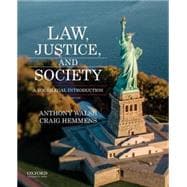An accessible and lively introduction to the field, Law, Justice, and Society: A Sociolegal Introduction, Fourth Edition, explores the relationship between legal systems and other social institutions using a distinctive sociological point of view.
Authors Anthony Walsh and Craig Hemmens provide detailed discussions of the various ways in which law impacts people based on race, class, gender, and age while also introducing students to the origins of the law, the history and development of the American legal system, the sociology of law, court structure, and the difference between civil and criminal law.








